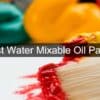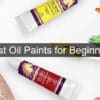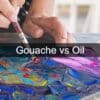Oil Paints Vs Acrylic Paints
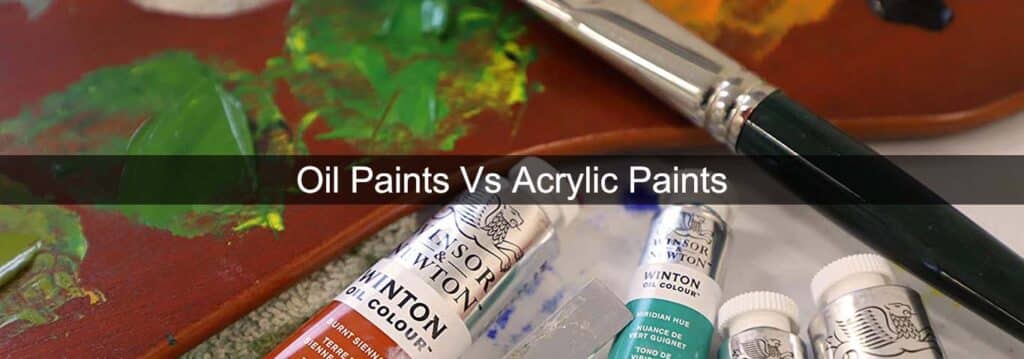
Want to know more about these two fabulous painting mediums?
Every famous painting around the world is mostly done by either acrylic paint or oil paint. “Mona Lisa” painted by Leonardo da Vinci was a masterpiece made with oil paint. “Mr and Mrs Clark and Percy” by David Hockney was painted with acrylic paint.
Both of the paints are equally famous and used worldwide. Acrylic paint is not a complex paint. It is a water-based paint and can change its character with mediums. They work across styles and techniques – from experimental applications to traditional painting styles. Differ from that oil painting is the process of painting with pigments with a medium of drying oil as the binder. It has been the most common technique for artistic painting on wood panels or canvas for several centuries, spreading from Europe to the rest of the world.
Though both of the paints are totally different from each other. We still want to know more about their differences, right?
Read on to take a look at the differences between these two paints and decide on which team you are on…
Binder of Acrylic and Oil paints
Binder refers to substances that hold the particles of pigment together in paint. All paints include a binder of some sort because this is what keeps the pigment in place after the paint dries. Binders provide a somewhat “slippery” ground preparation.
Acrylic paint has acrylic polymer as its binder, and this forms a film after the water has evaporated. Water is the vehicle for water-based acrylic, and when combined with the binder, it creates a polymer emulsion. Gesso is a flexible acrylic binder primer used to provide a white stable surface on which you paint. Although traditionally used by oil painters, the gesso often used today is acrylic gesso, which consists of slightly different ingredients.
Unlike acrylic paints, a binder of oil paints is the oil that is used in the paint. Commonly used drying oils include linseed oil, poppy seed oil, walnut oil, and safflower oil. The choice of oil imparts a range of properties to oil paint, such as the amount of yellowing or drying time.
Paper support for acrylic and oil paint

To compare acrylic and oil paint, the surface of the paper creates a huge difference. From a distance, paper or the canvas might not look like a major thing to compare, but actually, it is!
The most popular surfaces for acrylic painting with acrylics are canvas, wood, or paper. But once primed with gesso, acrylics can be painted on almost any surface. Artboards such as museum board, illustration board, or fiberboard are all ideal for painting with acrylic. Hot press paper will be the smoothest and is recommended for painting with acrylic paints. One thing about acrylic painting that is unique is that the paper takes up less room, it is lighter and less expensive than stretched canvas, making it easier to store, carry and post.
On the other hand, the most common surface for oil paints, and one that has been used for centuries, is stretched primed canvas. Alternatives include wood panels and medium density fiberboard (MDF), which last a long time and will not bend. The best paper for longevity is all-cotton or cotton & linen rag paper, which is essentially the same material used to make an artist’s work. 140 lb/300 gsm watercolor paper works well as it is heavy enough to take the weight of layers of primer and will not easily cockle from the moisture in the sizing.
Primer for oil and acrylic paintings
A primer seals and protects the canvas, makes it less absorbent, helps the colors stand out, and provides a smoother surface with enough tooth for the paint to bind onto. Acrylic and oil paint requires two different techniques of primer.
Latex primers prepare and promote the adhesion of acrylic paint. Acrylic matte medium works well for priming canvases too. It has a consistency similar to gesso so it’s easy to apply to the canvas with a brush. You can thin the first coat with just water and then start painting straight from the bottle. While painting on the wood surface, applying a thin layer of wood primer will help seal the wood, allowing the acrylic paint to apply easily. Acrylic primer can be kind of expensive.
For oil paints, paint primer keeps the paint solution from soaking into and eating away at the canvas fibers. It also keeps the canvas from turning brittle with age, as over time, oil oxidizes and makes the surface of the canvas more delicate and prone to cracking. You can coat it with an oil medium or latex bonding primer. If the original paint was really shiny, you’ll want to use a primer like Kilz. If it’s not too shiny, you can use a latex primer, then put a couple of latex coats over it. Always allow the primer to dry.
Brushes for acrylic paints and oil paints
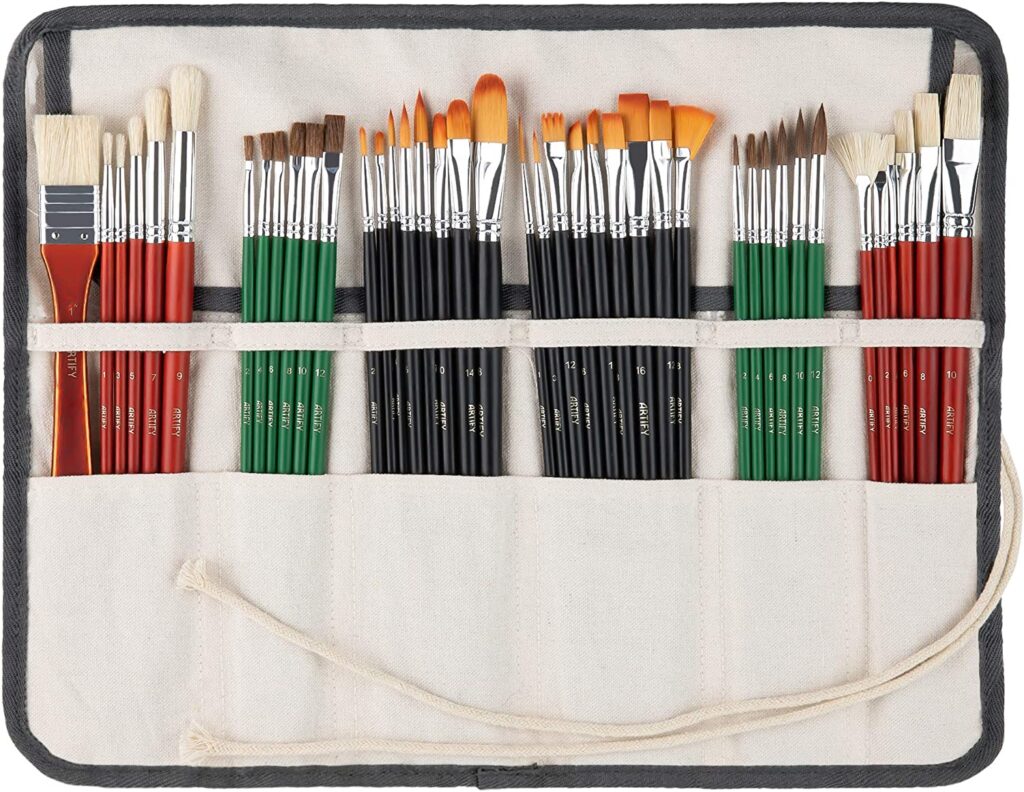
Brushes do not really make a difference between these two paints. Most oil brushes can be used for oils and acrylics as well.
Synthetic paint brushes are best for acrylic paints. There are eight main shapes to choose from – round, pointed round, flat, bright, filbert, angular flat, fan and detail round. Round and pointed round brushes have large bellies and taper to a point. The most popular brush for painting with acrylics is the round brush. You can also use natural-hair brushes on acrylics, but make sure that they’ve been cleaned of any oils or turpentine. Use odorless mineral spirits to clean them.
Unlike acrylic paint, the best paint brush for oil painting is a natural bristle brush. Nylon bristles are recommended for watercolor paint style, though most can also be used with oil paints. Natural hog bristle brushes are great because they have good stiffness and can hold more paint than synthetic brushes could. In oil painting, large bristle brushes are best for washes and broad areas of backgrounds. Mid-size bristle brushes with sharp edges can also be used for some detailing and blending techniques. Finer details are best accomplished with small, thin and round sable brushes.
Water or other mediums for acrylic and oil paints
Use of water or other mediums like oil or turpentine or acrylic polymer emulsion creates major differences between oil and acrylic painting.
Some sources advise not to mix acrylic paint with more than 50 percent water. Any more than this may cause the polymer in the acrylic paint to break down and lose its adhesive qualities, resulting in peeling or flaking at some stage or the lifting of the paint when you paint subsequent layers. Adding up to 30 percent water to acrylic paint thins it but still allows it to coat a surface. Adding 60 percent or more water creates a watery paint application called a wash. If you are using acrylics from a tube or a jar, first wet the paintbrush and then drip a bit of water onto the paint and mix it together until it gets nice and fluid. Keep adding water if necessary.
While you can use water to thin water soluble oil paints, it may not be your best option or painting medium. Straight water will often create a duller color and stickier paint that doesn’t brush easily or work well when other oils are added. The choice of oil imparts a range of properties to the paint, such as the amount of yellowing or drying time. Painting with a dry brush will give you a more textural effect, which is perfect for painting brick or dirt. The paint could be thinned with turpentine. Cooking oils such as canola or safflower are cheaper than solvents and, surprisingly – they work! The best choices are linseed oil, poppy seed oil, walnut oil, and safflower oil.
Drying process of oil painting and acrylic paint
Drying time does make a big difference in these two paint mediums.
It tends to take professional acrylic paints from twenty minutes to half an hour to dry such that you can touch them without leaving a mark if applied in a thin layer. You don’t have to use any fast-drying paint mediums. Based on the environment you paint in, one to two hours is the drying time for thick paint layers. If you paint thinner, it might take less time.
On the other hand, oil painting dries after 18 to 24 hours! This range of oil paints has a high proportion of single pigments providing brilliant mix colours even when mixed. However, the thicker paint medium will make a difference to the drying times, obviously, the thinner the layer of paint the quicker the drying time. Oil paints dry faster in a warm atmosphere. The painting process might make a difference in the drying process as well.
Finish look of oil paint and acrylic paint
Both of the paints give similar finish looks.
Acrylic paint dries smooth and is somewhat rubbery-looking. This painting is, however, still textured and is therefore like an oil painting in that respect. Acrylic mediums are naturally glossy. Using a matte medium can give you a more subtle, non-reflective finish. You can also mix gloss and matte mediums together in equal parts to achieve a kind of semi-gloss/ satin effect.
A glossy finish is one of the most popular finish looks of oil paint. But just because you are painting with oils doesn’t mean you will have glossy results. Sometimes, using some specific primer or oil paint medium or painting tips on the canvas can give you a matte finish with oil paint. Generally, oil paints become touch dry in thin films within 2 to 12 days, but the different reactions of different pigments when mixed with oil result in varying paint dry timing, which will affect your work. There are many different reasons artists choose to paint with oil paint. Numerous blending capabilities, longer working time, and rich and vibrant colors all being some of these reasons.
Varnishing the art
Dust and grime can accumulate on the surface of paintings over time, especially if a painting hangs in a smoky environment. The protective layer of varnish can be removed to restore the painting to its original look, though some colour might look different before and after varnishing.
It is essential that you varnish your completed acrylic paintings. The varnish will protect the painting from dust, UV rays, and yellowing. In general, acrylic resin varnishes are glossier, stronger, and clearer than acrylic polymer varnishes. Therefore, if you want a high-gloss finish, you should go for an acrylic resin varnish. Before applying the final varnish, you’ll need to apply an “isolation coat” over the entire painting. While varnishing, hold the brush at a right angle of 10° to the surface and work in the direction of the grain, lightly skim the varnish with the bristle tips to help level it.
It’s necessary to varnish oil paintings in order to protect the paint film. Since resin is the essential ingredient of varnish, it’s more convenient to purchase a varnish than to make your own. There are traditional varnishes, the most common of which is damar. One can use light, even strokes to spread the varnish around the piece consistently. It is recommended to apply one to three thin layers rather than big thick layers.
Cleaning the art
Cleaning is the most important part of preserving beautiful paintings. Whether it’s two days old or two hundred centuries old, you just have to clean it to keep it fresh and lively.
Magna (a solvent-based acrylic resin) can be used to clean acrylic paints. You can also use soap and water to clean an acrylic painting. Just dip a soft cloth or paper towel in warm, soapy water, so it’s barely damp, and carefully wipe down the painting with it. Keep in mind to choose the soap according to painting mediums.
But if we look at oil paints, then the simplest way to clean up oil or acrylic paints on canvas is to use olive oil-based soaps. It works like magic. You’ll be surprised to see how much grime comes off. You just have to be gentle with paintings with thick impasto as you do not want to break hardened paint. Sunlight can cause irreversible damage to oil paintings, ranging from loss of sheen and vibrancy to darkening of the varnish.
Gouache vs Oil vs Acrylic paint
Gouache, oil, and acrylic paint; three of them have different binders, different finishing, and textures.
The most common binder employed in gouache is a combination of gum arabic, various plasticizers, and preservatives. For oil painting, the pigments mixed with a medium of drying oil work as the binder. Again for acrylic paint, acrylic polymer plays the role of its binder and this forms a film after the water has evaporated. Water is the vehicle for water-based acrylic paint, and when combined with the binder, it creates a polymer emulsion.
FAQS
Which of them is recommended for beginners?
Acrylic paint is widely considered as a friend to a beginner painter. Oil paints work fine but mixing binder and choosing the perfect binder for the perfect surface might be tough for beginners.
Can acrylic and oil paint mix together?
It is not a good idea to mix oil paint and acrylic paints together on your palette before applying them to the canvas. Acrylics are water-based, and oils are oil-based, so they each have different properties and different needs.
Do professional artists prefer acrylic or oil paint?
It depends on person to person, artist to artist. Famous artists usually use oil paints for portrait painting. Both oil and acrylic paints have been used to create some of the most famous paintings in the world.
Which paint dries faster?
Acrylics dry much faster than oil paints. Mostly, all wet oil paint/oil-based paints take time to dry.
Affiliate Disclosure
In compliance with the FTC guidelines, please assume the following about all links, posts, photos and other material on this website: Any/all of the links on this website are affiliate links of which The Big Red Illustration Agency receives a small commission from sales of certain items, but the price is the same for you. www.bigredillustrationagency.com is a participant in the Amazon Services LLC Associates Program, an affiliate advertising program designed to provide a means for sites to earn advertising fees by advertising and linking to Amazon.com & Amazon.co.uk. Pages on this site may include links to Amazon and its affiliate sites on which the owner of this website will make a referral commission.
FULL TERMS HERE Cookie preferences: cookie preferences

Written By Adam Rushton
Adam has made a name for himself in the illustration industry and is a passionate blogger and writer on the subject of art, illustration and graphic design.
His artwork has been featured in countless publications and used for very well-known media projects. As a professional illustrator for over 20 years, Adams media outlets, a wealth of knowledge, and experience enable him to consult and advise artists and illustrators in this country (from York and Manchester to Southampton and London) and all over the world.











